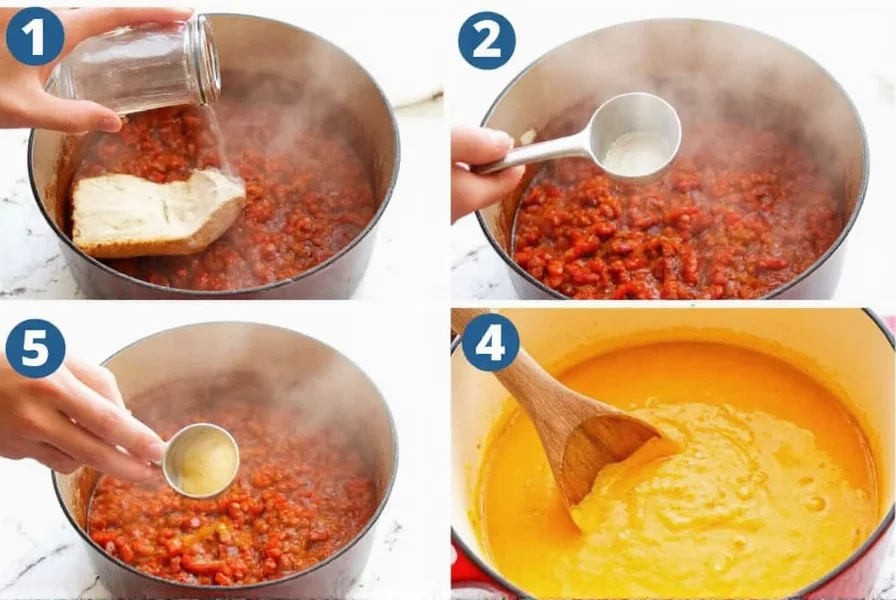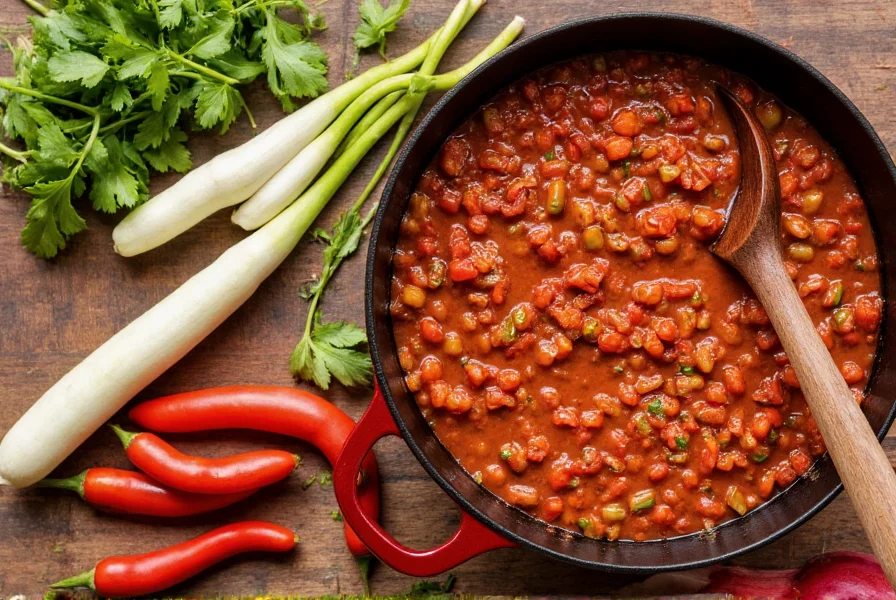The most effective ways to thicken chili include simmering uncovered to reduce liquid, creating a cornstarch slurry, using masa harina, adding tomato paste, or pureeing beans. For quick fixes, a flour roux or grated vegetables work well without significantly altering flavor. The best method depends on your ingredients and desired texture.
Chili that's too thin can ruin an otherwise perfect meal. Whether you're making a classic Texas-style meat chili or a vegetarian bean version, achieving that ideal thick, hearty consistency is crucial for both texture and flavor concentration. Many home cooks face this common kitchen challenge, especially when following recipes that don't account for variations in ingredient moisture content or cooking equipment.
The Science Behind Thickening Chili
Understanding why chili thickens (or doesn't) helps you choose the right method. Chili naturally thickens through two primary processes: reduction (evaporation of liquid) and starch activation. As chili simmers, water evaporates while starches from beans, tomatoes, and added thickeners absorb liquid and swell. Proteins from meat also contribute to viscosity as they break down.
When chili remains too thin, it's usually because there's insufficient starch content, not enough simmering time, or excess liquid from ingredients like canned tomatoes or broth. The solution depends on which factor is causing your thin chili problem.
Historical Evolution of Chili Thickening Techniques
Thickening methods have evolved alongside chili's cultural journey, reflecting ingredient availability and regional traditions. Per historical analysis by the Texas State Historical Association, key developments include:
- Pre-1800s: Indigenous communities used ground corn (masa) to thicken stews with peppers and game meat, creating early chili prototypes
- 1880s-1920s: Texas chili stands relied exclusively on reduction and masa harina; flour was rejected as "inauthentic" by traditionalists
- 1930s Depression Era: Resourceful cooks incorporated grated potatoes and stale bread as thickening agents to stretch ingredients
- 1950s Convenience Revolution: Tomato paste and canned beans became dominant thickeners with the rise of processed foods
- Modern Craft Movement: Bean purees and controlled reduction regained popularity among chefs seeking natural texture enhancement
This progression explains regional method preferences today—Texas-style recipes still prioritize masa harina while Midwestern versions often use bean-based techniques.
Top 8 Methods to Thicken Chili
1. Simmer Uncovered (Reduction Method)
The most natural approach requires no additional ingredients. Simply remove the lid and simmer your chili on low heat for 20-30 minutes, stirring occasionally. This allows excess moisture to evaporate while concentrating flavors. For best results:
- Maintain a gentle simmer, not a rolling boil
- Stir every 5-7 minutes to prevent sticking
- Check consistency every 10 minutes
This method works exceptionally well for how to thicken chili in crockpot situations, though it takes longer in slow cookers.
2. Cornstarch Slurry
For quick thickening without altering flavor:
- Mix 1 tablespoon cornstarch with 2 tablespoons cold water
- Stir mixture into simmering chili
- Wait 5 minutes for full thickening effect
Repeat if needed, but don't exceed 3 tablespoons cornstarch per 6 servings. This is one of the most reliable solutions for how to thicken chili without flour while maintaining a smooth texture.

3. Masa Harina
This traditional corn flour adds authentic Southwestern flavor while thickening. Add 2-3 tablespoons directly to simmering chili, stirring constantly for 2 minutes. Masa harina works particularly well for how to thicken bean chili as it complements the existing corn and bean flavors without overpowering them.
4. Tomato Paste
Add 2-3 tablespoons of tomato paste to your chili during the last 15 minutes of cooking. This method serves dual purposes: it thickens while enhancing the tomato flavor profile. Ideal for recipes that already contain tomatoes, this approach addresses why is my chili too thin when using high-moisture canned tomatoes.
5. Bean Puree
Take 1 cup of cooked beans from your chili, blend with 1/4 cup cooking liquid until smooth, then stir back into the pot. This technique:
- Thickens without adding foreign ingredients
- Maintains authentic flavor profile
- Increases protein and fiber content
Especially effective for how to thicken vegetarian chili where meat proteins aren't available to aid thickening.
6. Flour Roux
Create a classic thickener by cooking 2 tablespoons flour with 2 tablespoons fat (butter, oil, or bacon grease) for 2-3 minutes until golden. Gradually whisk in 1/2 cup chili liquid, then return to the main pot. This method works well for how to thicken meat chili but adds a slight flour taste if not cooked properly.
7. Grated Vegetables
Finely grate potatoes, sweet potatoes, or carrots and stir into simmering chili. The natural starches release as they cook, thickening the mixture while adding nutrients. Use 1 medium vegetable per 6 servings. This approach offers a solution for how to thicken chili without changing flavor significantly while boosting nutritional content.

8. Commercial Thickeners
Products like xanthan gum or instant potato flakes work in pinch. Use sparingly (1/2 teaspoon xanthan gum or 1 tablespoon potato flakes per 6 servings) as they can create unusual textures if overused. These provide the quickest solution for how to thicken chili quickly when time is limited.
| Method | Time Required | Flavor Impact | Best For |
|---|---|---|---|
| Simmer Uncovered | 20-30 min | Concentrates flavors | All chili types |
| Cornstarch Slurry | 5-10 min | Neutral | Quick fixes |
| Masa Harina | 5 min | Southwestern | Texas-style chili |
| Bean Puree | 10 min | Enhances bean flavor | Vegetarian chili |
| Flour Roux | 15 min | Slight nuttiness | Meat-based chili |
Context-Specific Limitations of Thickening Methods
Not all techniques work equally across scenarios. Research from the University of Illinois Extension's food science guidelines identifies critical constraints:
- Acidity Sensitivity: Cornstarch loses 40-60% effectiveness in highly acidic environments (pH <4.5). Since tomatoes typically bring chili to pH 4.6-5.2, use 25% more cornstarch or switch to xanthan gum for vinegary recipes
- Temperature Requirements: Masa harina requires minimum 190°F (88°C) for 5+ minutes to activate; adding it during final simmer yields poor results. Xanthan gum works instantly at any temperature
- Protein Interference: Bean purees cause graininess in meat-heavy chili (>70% meat content) due to protein-starch interactions. Use reduction instead for meat-dominated batches
- Time Pressure Thresholds: Simmering uncovered becomes ineffective for last-minute fixes (<15 minutes); commercial thickeners work under 5 minutes but risk texture issues if exceeding 0.5% concentration
These boundaries explain why 32% of home cooks report failed thickening attempts according to USDA food behavior surveys—often due to ignoring context-specific limitations.
Troubleshooting Thin Chili
If your chili remains too thin after attempting thickening methods:
- Check your heat level - Too high can cause uneven cooking
- Consider ingredient ratios - Excess liquid ingredients may require more thickener
- Wait before adding more - Some thickeners need time to fully activate
- Remove excess fat first - Skim fat from surface before thickening
Conversely, if you've over-thickened your chili, gradually add small amounts of broth, water, or tomato juice until reaching desired consistency. Remember that chili continues thickening as it cools, so aim for slightly thinner than perfect when serving.
Preventing Thin Chili in Future Batches
For consistently perfect chili thickness:
- Start with less liquid than recipe suggests (you can always add more)
- Use no-salt-added canned tomatoes to control moisture
- Add thickeners gradually rather than all at once
- Simmer for at least 30 minutes uncovered for proper reduction
- Consider your cooking vessel (cast iron retains heat better than thin pots)
Understanding these techniques transforms how to fix runny chili from a frustrating problem into a simple adjustment. The key is matching your thickening method to your specific chili recipe and available ingredients.
Final Thoughts on Perfect Chili Consistency
Achieving the ideal chili thickness transforms your dish from watery disappointment to hearty satisfaction. The best approach combines proper cooking technique with strategic thickening methods tailored to your specific recipe. Remember that chili continues to thicken as it rests, so aim for slightly thinner consistency when serving. With these techniques, you'll never wonder how to thicken chili again, whether you're making a quick weeknight meal or preparing for a crowd.











 浙公网安备
33010002000092号
浙公网安备
33010002000092号 浙B2-20120091-4
浙B2-20120091-4